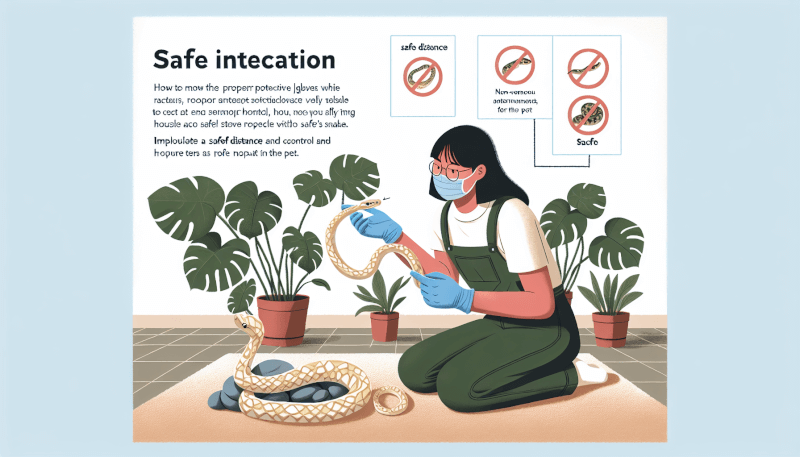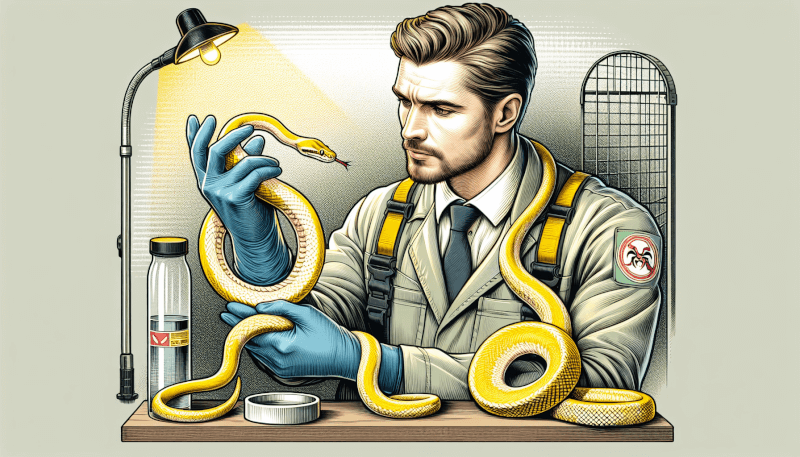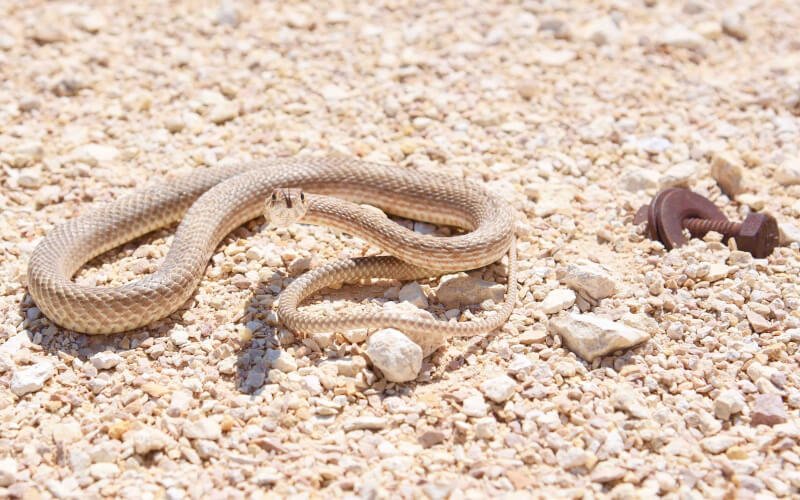When it comes to handling and interacting with pet snakes, ensuring proper safety is essential. From understanding the behavior and body language of snakes to knowing the correct handling techniques, there are several key factors to consider in order to keep both yourself and your pet snake safe. In this article, you will discover valuable tips and guidelines that will help you navigate the world of pet snake ownership and ensure a safe and enjoyable experience for both you and your scaly friend. So whether you’re a seasoned snake owner or considering getting a pet snake for the first time, read on to discover how you can guarantee proper safety in all your snake-handling adventures.
Choosing the Right Snake
When it comes to choosing a snake as a pet, there are several factors to consider. Researching different snake species is the first step in making an informed decision. Each species has its own unique characteristics, such as size, temperament, and care requirements. It’s essential to choose a snake species that aligns with your preferences and lifestyle.
Researching Different Snake Species
Before getting a snake, take the time to research different snake species. Learn about their natural habitats, behavior, and specific care needs. Some popular snake species for beginners include ball pythons, corn snakes, and king snakes. These species are relatively docile, easy to handle, and require less complicated care.
Considering Size and Temperament
One crucial aspect to consider when choosing a snake is its size. Snakes come in various sizes, ranging from small colubrids like milk snakes to large pythons and boas. Keep in mind that larger snakes require more space and may be more challenging to handle. Additionally, consider the temperament of the snake species you are interested in. Some snakes are more aggressive or skittish than others, requiring experienced handlers or a calm and patient approach.
Understanding Venomous vs. Non-Venomous Snakes
Another critical consideration is whether you want a venomous or non-venomous snake. Venomous snakes like rattlesnakes or cobras should only be kept by experienced snake handlers or professionals. If you are a beginner or not comfortable with the risks associated with venomous snakes, it’s best to choose a non-venomous species. Non-venomous snakes still require caution and responsible handling, but they pose less of a risk to their owners.
Creating a Safe Environment
Creating a safe environment for your pet snake is crucial for its well-being. Snakes thrive when provided with proper housing conditions, temperature gradients, and hiding spots.
Setting Up the Right Enclosure
Start by setting up an appropriate enclosure for your snake. The enclosure should be escape-proof, with secure lids or locks. Consider the size of your snake and provide a habitat that allows for adequate movement and exploration. Choose a substrate that mimics the snake’s natural environment and is easy to clean. Providing the snake with appropriate climbing branches, rocks, or hides will help create a stimulating and enriching environment.
Maintaining Proper Temperature and Humidity
Snakes are ectothermic, meaning they rely on external heat sources to regulate their body temperature. It’s vital to provide a temperature gradient within the enclosure, allowing the snake to thermoregulate. Use heat mats, heat lamps, or ceramic heaters to create a warm side and a cooler side in the enclosure. Additionally, monitor and maintain proper humidity levels, as different snake species have varying humidity requirements. This can be achieved by using a hygrometer and misting the enclosure as needed.
Providing Adequate Hiding Spots
Snakes are secretive animals and require hiding spots to feel secure. Place multiple hiding spots throughout the enclosure, such as caves or snug hide boxes. These hiding spots should be appropriately sized for the snake and located in different temperature zones. Snakes will use these hiding spots when they feel stressed, threatened, or when they are preparing to shed their skin. Providing ample hiding spots helps reduce stress and promotes overall well-being.
Handling Techniques
Proper handling techniques are crucial for both your safety and the well-being of the snake. It’s essential to acclimate the snake to human interaction, create a calm environment, and use proper handling tools.
Acclimating the Snake to Human Interaction
When you first bring your snake home, give it time to acclimate to its new environment before attempting to handle it. Once the snake is settled, slowly introduce short handling sessions. Start with brief periods of touch and gradually increase the duration. Handle the snake gently and avoid any sudden movements that may startle or stress the reptile. Over time, the snake will become more comfortable with human interaction.
Ensuring a Calm and Controlled Environment
When handling your snake, it’s crucial to create a calm and controlled environment. Find a quiet space where the snake feels secure, away from loud noises or sudden distractions. Avoid handling the snake during feeding or just after it has eaten, as this can trigger defensive behaviors or regurgitation. Keep in mind that snakes are more likely to be stressed or defensive when shedding their skin, so it’s best to avoid handling during this time.
Using Proper Handling Tools
Proper handling tools can make the handling experience safer and more comfortable for both you and your snake. Snake hooks or snake tongs allow you to maintain a safe distance and provide support when moving the snake. These tools are especially useful when handling larger or more nervous snakes. It’s important to remember that your snake may become stressed if handled too frequently or roughly, so always prioritize its well-being over personal interaction.
Recognizing Signs of Stress and Aggression
Understanding and interpreting your snake’s body language and behavior are vital for recognizing signs of stress or aggression. By identifying these signs early on, you can implement strategies to reduce stress and prevent potential bites.
Understanding Common Stressful Situations
There are several situations that can cause stress for your pet snake. These include sudden loud noises, fast movements, handling that exceeds the snake’s comfort level, or inappropriate enclosure conditions. Pay attention to your snake’s behavior during these situations, as prolonged stress can lead to health issues or defensive behaviors.
Interpreting Body Language and Behavior
Snakes communicate through their body language and behavior, and it’s essential to learn how to interpret these signals. Some common signs of stress or aggression in snakes include hissing, lunging, raised head or body postures, excessive tongue flicking, or prolonged hiding. These signs indicate that the snake feels threatened or defensive. If you observe these behaviors, it’s best to back off and give the snake space to calm down.
Implementing Strategies to Reduce Stress
If you notice signs of stress in your snake, it’s crucial to implement strategies to reduce stress and create a more comfortable environment. Make sure the enclosure provides a proper temperature gradient, appropriate humidity levels, and sufficient hiding spots. Avoid exposing the snake to stressful situations, like excessive handling or changes in its environment. By minimizing stress, you can help promote the overall well-being and happiness of your pet snake.
Avoiding Snake Bites
Snake bites can be avoided with proper precautions and understanding of snake behavior. Learn about snake bite prevention, identifying warning signs of aggression, and using protective gear.
Learning about Snake Bite Prevention
Snake bite prevention starts with understanding and respecting snake behavior. Educate yourself about the specific behavior and warning signs of aggression for the snake species you own. Avoid handling the snake when it’s stressed, defensive, or in a feeding mode. Being aware of the snake’s body language and taking necessary precautions can help prevent snake bites.
Identifying Warning Signs of Aggression
Warning signs of aggression in snakes can include hissing, sudden coiling or striking, and displaying a defensive body posture. These signs indicate that the snake is feeling threatened and may bite if further provoked. It’s crucial to be able to recognize these warning signs and back off accordingly.
Using Protective Gear
When handling your snake, it’s a good idea to use protective gear to minimize the risk of snake bites. Thick gloves made specifically for handling reptiles can provide an extra layer of protection. However, keep in mind that gloves may hinder your sense of touch and should not be relied upon as a substitute for proper handling techniques and caution.
Proper Feeding and Nutrition
Providing your snake with proper feeding and nutrition is essential for its overall health and well-being. Understanding the snake’s dietary requirements, choosing the right prey items, and establishing a feeding schedule are key components of proper care.
Understanding the Snake’s Dietary Requirements
Different snake species have varying dietary requirements, so it’s important to understand the specific needs of your snake. Most snakes are carnivorous, feeding on rodents, birds, or other small animals. Some larger species, like pythons, may require larger prey items or even whole prey. Research and consult with reputable sources to ensure you are feeding your snake a well-balanced diet.
Choosing the Right Prey Items
When choosing prey items for your snake, it’s crucial to select appropriately sized prey that matches the snake’s size and feeding abilities. Prey items should not be too large or too small, as this can cause feeding difficulties or nutritional imbalances. Feeder animals should also be purchased from reputable sources to ensure they are healthy and free of parasites or diseases.
Establishing a Feeding Schedule
Establishing a regular feeding schedule is beneficial for both you and your snake. Snakes thrive on a consistent feeding routine, so try to feed your snake at the same time and on the same days each week. Young snakes may require more frequent feedings, while adult snakes typically eat less frequently. It’s important not to overfeed your snake, as this can lead to obesity and other health problems.
Maintaining a Clean Environment
Maintaining a clean environment for your snake is essential for its health and hygiene. Regularly cleaning the enclosure, handling waste and shedded skin, and preventing the spread of diseases will help ensure a safe and healthy living environment.
Regularly Cleaning the Enclosure
Cleaning the snake’s enclosure on a regular basis is crucial for maintaining a clean and hygienic environment. Remove any uneaten prey items, feces, shedded skin, or soiled substrate promptly. Clean the enclosure with a reptile-safe disinfectant, following the manufacturer’s instructions. Regular cleaning helps prevent the growth of harmful bacteria and reduces the risk of infections.
Handling Waste and Shedded Skin
Snakes produce waste, which needs to be handled properly. Use gloves when handling waste and dispose of it in the appropriate manner, following local regulations or guidelines. Shedded skin is a natural occurrence for snakes and should be left in the enclosure as a source of enrichment. However, if the shedded skin is not removed naturally by the snake, it can be gently removed with tweezers to prevent it from becoming a breeding ground for bacteria or mites.
Preventing the Spread of Diseases
Snakes can be susceptible to various diseases, some of which can be transmitted to humans or other animals. It’s important to practice good hygiene and take precautions to prevent the spread of diseases. Wash your hands thoroughly before and after handling your snake or cleaning the enclosure. If you have multiple snakes, avoid cross-contamination by using separate equipment for each snake and isolating any sick snakes to prevent the transmission of diseases.
Handling Potential Health Issues
As a responsible snake owner, it’s essential to be aware of common snake diseases and illnesses. Understanding the symptoms and knowing when to seek veterinary care are crucial steps in maintaining the health and well-being of your pet.
Knowing Common Snake Diseases and Illnesses
Educate yourself about common snake diseases and illnesses that can affect your pet. Some common health issues in snakes include respiratory infections, parasitic infestations, and metabolic bone disease. Learn about the symptoms and causes of these conditions, as well as how to prevent and treat them.
Recognizing Symptoms and Seeking Veterinary Care
Being able to recognize the early signs of illness or injury in your snake is essential for their well-being. Changes in appetite, weight loss, abnormal shedding, lethargy, respiratory issues, or visible lesions or abnormalities should not be ignored. If you notice any concerning symptoms, it’s important to seek veterinary care from a reptile specialist or veterinarian experienced in snake health. Early intervention can significantly improve the chances of successful treatment and recovery.
Administering Medication Safely
If your snake requires medication, it’s important to follow veterinary instructions and administer it safely. Snakes can be sensitive to medications and dosages, so it’s vital to consult with a reptile veterinarian for proper guidance. Follow medication schedules precisely and make sure to monitor your snake’s behavior and response to treatment. Handling and medicating a snake may require precautions and specialized techniques, so always prioritize the safety and well-being of your snake.

Educating Others about Snake Safety
As a snake owner, you have the opportunity to educate others about snake safety and responsible ownership. Sharing your knowledge with friends and family, informing visitors about snake handling guidelines, and educating the public on responsible snake ownership are all ways to promote awareness and safety.
Sharing Knowledge with Friends and Family
Take the time to educate your friends and family about snake safety and responsible ownership. Share what you have learned about proper handling techniques, enclosure setup, and potential risks associated with snakes. Help dispel common myths or misconceptions about snakes and promote understanding and respect for these fascinating creatures.
Informing Visitors about Snake Handling Guidelines
If you have visitors who are interested in interacting with your snake, it’s important to provide them with clear guidelines and instructions for safe handling. Emphasize the importance of calm and gentle handling, and inform them about any specific behaviors or sensitivities your snake may have. Always supervise interactions with your snake to ensure the safety of both the snake and the visitor.
Educating the Public on Responsible Snake Ownership
Take the opportunity to educate the public about responsible snake ownership and dispel common fears or misunderstandings about snakes. You can participate in local reptile expos, give presentations at schools or community events, or engage with social media platforms to share your knowledge and promote responsible snake ownership. By educating the public, you contribute to the overall safety and well-being of both snakes and their owners.
Seeking Professional Help
Sometimes, seeking professional help is necessary for the care of your pet snake. Consulting with reptile veterinarians or herpetologists, joining reptile enthusiast communities, and attending snake handling courses or workshops can provide valuable support and guidance.
Consulting with Reptile Veterinarians or Herpetologists
Reptile veterinarians or herpetologists are professionals with specialized knowledge and experience in snake care. If you encounter any health issues or have concerns about your snake’s well-being, consult with a reputable reptile veterinarian. They can provide medical advice, perform health checks, and offer treatment options tailored to your snake’s needs. Herpetologists are experts in the study of reptiles and can provide valuable information and guidance for snake enthusiasts.
Joining Reptile Enthusiast Communities
Joining reptile enthusiast communities or online forums can provide a wealth of information and support for snake owners. Engage with fellow snake enthusiasts, share experiences, and ask questions. These communities often have experienced members who can offer advice and guidance based on their own experiences. Connecting with like-minded individuals can be an enriching and supportive experience.
Attending Snake Handling Courses or Workshops
Snake handling courses or workshops are available for those who want to learn more about safely handling snakes. These educational opportunities provide hands-on experience, guidance from experts, and opportunities to practice proper handling techniques. Attending these courses or workshops can increase your confidence and competence in handling snakes, ensuring the safety and well-being of both you and your pet.
In conclusion, ensuring proper safety during handling and interactions with pet snakes is of paramount importance. By researching different snake species, creating a safe environment, using proper handling techniques, recognizing signs of stress and aggression, avoiding snake bites, providing proper feeding and nutrition, maintaining a clean environment, handling potential health issues, educating others about snake safety, and seeking professional help when needed, you can ensure a safe and enriching experience for you and your pet snake. Enjoy the rewarding journey of responsible snake ownership, and always prioritize the continued well-being and happiness of your scaly companion.



